
Can’t make it to PaleyFest in LA tomorrow? Catch the stars of Outlander March, 12 at 8:10 p.m. PT, on @YahooScreen. http://paley.me/outlander

Human Anatomy taught through the lens of the Outlander books by Diana Gabaldon and the Starz television series

Can’t make it to PaleyFest in LA tomorrow? Catch the stars of Outlander March, 12 at 8:10 p.m. PT, on @YahooScreen. http://paley.me/outlander
The belly has many synonyms: abdomen, beer belly, breadbasket, girth, gut, guts, insides, maw, middle, midriff, paunch, pot, potbelly, spare tire, stomach, tum, and tummy to name a few. Although not a synonym, there is only one word for Jamie’s belly and that is spectacular! Greetings everyone and welcome to Anatomy Lesson #16: The Anterior Abdominal Wall.
This lesson will explore bones, muscles and skin that comprise the belly along with surface landmarks that you may have observed but didn’t recognized as either important or significant. In this lesson, I use the term anterior abdominal wall or the simpler belly wall and hope that by its end you will enjoy a greater appreciation for its complexity, purpose and design.
Herself refers to the belly many times in her writings, but the verra first time we encounter the term is in Outlander where Claire’s belly rumbles loudly in protest of lack of food (BTW, rumblings or growling by the intestines is due to muscle contraction of the gut wall and is called borborygmi – pronounced BOR-boh-RIG-mee). Our ever gallant hero offers her a strong drink (Starz episode 1, Sassenach):
“A moment later, a hand with a flask came around in front of me again. “Better have a wee nip,” he whispered to me. “It willna fill your belly, but it will make ye forget you’re hungry.” And a number of other things as well, I hoped. I tilted the flask and swallowed.”
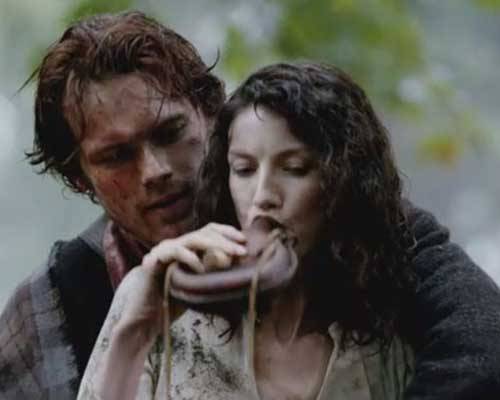
The first time we see Jamie’s belly is Starz episode 2, Castle Leoch after Claire uncovers his back to properly clean and dress his gunshot wound. A number of important surface features are wonderfully demonstrable on Jamie’s belly but in the words of Dougal, we’ll puzzle those out later. One look at Jamie’s bare torso and is it any wonder Claire drops her cleaning cloth? Gah!
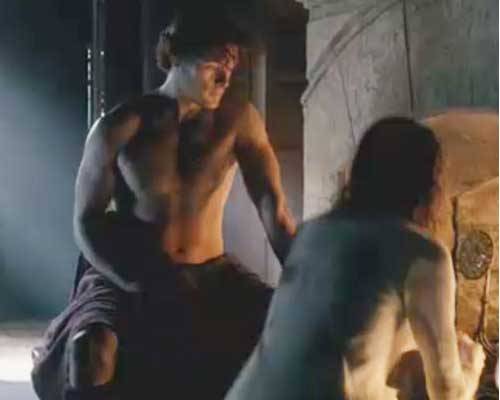
But the first time we read about Jamie’s belly is in Outlander book as Dougal tells Claire about BJR’s flogging of Jamie. Herself writes:
“His mouth tightened up and he says, ‘I thought this was the young man who only a week past was shouting that he wasn’t afraid to die.Surely a man who’s not afraid to die isn’t afraid of a few lashes?’ and he gives Jamie a poke in the belly wi’ the handle of the whip.”
Weel, this looks a wee bit more serious than a poke. The sadistic bastard punches Jamie very hard in the belly with the handle of his cat o’ nine tails (Starz episode 6, The Garrison Commander).
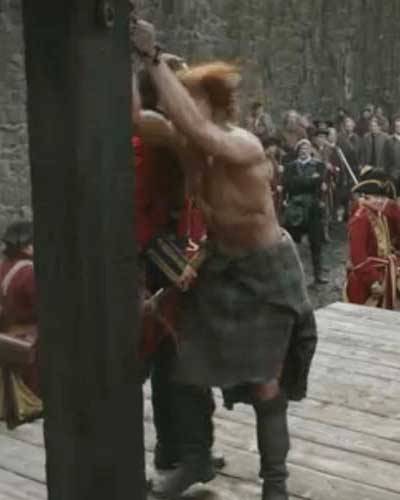
Continuing the quote:
“Jamie meets Randall’s eye straight on then, and says,‘No, but I’m afraid I’ll freeze stiff before ye’re done talking.’ ” In otherwords, quit yer yapping BJR and get on with it! Weel, it was a braw speech for which BJR flogs him even harder.
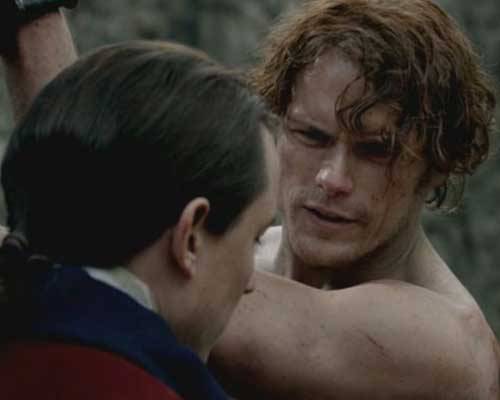
But, let’s leave this sad scene for our anatomy lesson. The abdomen is that part of the trunk between ribs and pelvis (Photo A– blue overlay). Its front and sides are bounded by flexible fibromuscular walls formally known by the lengthy name, anterolateral abdominal wall. As explained earlier, I will use the simpler anterior abdominal wall or belly wall. The posterior (back) abdominal wall is bulkier and less elastic but it doesn’t concern us today.
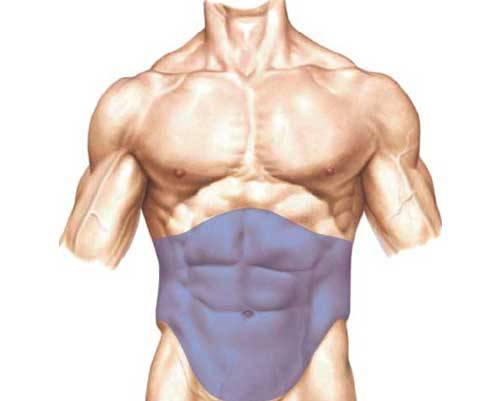
Photo A
The bony framework for the anterior abdominal wall includes xiphoid process and costal margins and parts of the hip bones: anterior superior iliac spine, iliac crest, pubic symphysis and pubic tubercle.
These bony landmarks are often palpated during physical examination. If you read Anatomy Lesson #15, you have already found xyphoid process and costal margins (Photo B – red arrows).
Try this: If you can, lie on your back and relax the tummy. At your sides, locate the point of each hip bone; these are the anterior superior iliac spine or ASIS (Photo B). From the ASIS, press fingers backward along the flared iliac crests. Next, place fingers on the navel and move down to the tops of the pubic bones. You may feel a midline indentation or pubic symphysis, a disc of specialized cartilage that binds together the paired pubic bones; this disc softens during pregnancy. Run fingers along the top of one pubic bone until you feel a smallish bony knob, one of the paired pubic tubercles.
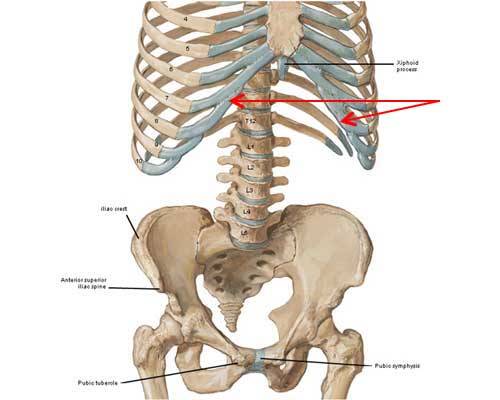
Photo B
The abdominal walls form a flexible and dynamic container for the abdominopelvic cavity which is more extensive than the abdomen because it reaches from the domed thoracic diaphragm above (Photo C – red arrow and Anatomy Lesson #15) to the sunken pelvic diaphragm (floor) below. The cavity contains most digestive and urogenital organs and is subdivided into upper abdominal cavity (yellow in Photo C) and lower pelvic cavity (Green in Photo C). The abdominopelvic cavity is lined with peritoneum, a serous (wet) membrane that clings to inner walls of the cavity and covers organ surfaces. In males, the peritoneum is a closed sac but in human females the sac has two openings one at the mouth of each uterine tube to allow passage of ova.

Photo C
The belly wall may seem simple but it is very complex and critical for our well being. A simple note about orientation before we dissect the belly wall: in anatomy and medicine right (R) and left (L) are defined as the patient’s R and L and not those of the viewer.
Viewed in cross-section (penny-sliced), the belly wall is composed of several tissue layers. The outer layer is belly skin and the innermost is peritoneum (Photo D). Belly skin bears a number of important landmarks we will discuss shortly. Jamie is our model for that. He is always soooo willing. Thank you Big Ruadh One!
The belly wall includes four pairs of muscles known at the gym as abs. Paired rectus abdominis (RA) muscles flank the midline. Each side has three flat muscles from superficial to deep: external
oblique (EO), internal oblique (IO) and transversus abdominis (TA).
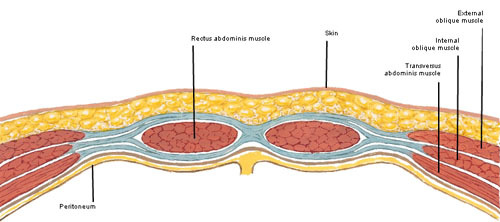
Photo D
The bluish structures in Photo E are fibrous tissues of the belly wall. These include a midline linea alba (Latin meaning white line) and the paired rectus sheaths. Let’s take a closer look.

Photo E
Photo F, shows a superficial dissection of the belly wall exposing linea alba and R rectus sheath. Linea alba is a midline fibrous line. Each rectus sheath is a fibrous envelope extending from ribs above to pubic bone below. The following explains their anatomy: at the mid-clavicular line (Photo F – dashed red line) EO, IO and TA change from muscle to flat fibrous sheets. These sheets envelope each RA muscle as a rectus sheath. In the midline, the sheets meet and decussate (crossover) to form the fibrous linea alba. Amazingly, an incision along linea alba allows an almost bloodless entry into the abdominal cavity as only tiny blood vessels cross the midline.
This is interesting: see the structure labelled spermatic cord (Photo F)? Paired spermatic cords suspend the testes (pl.) in the scrotum and contain structures running to and from these organs. You may think it odd to mention spermatic cords in a belly wall lesson but anatomists teach them here because their layers are derived from the belly wall. Each spermatic cord traverses the inguinal canal (not shown) an oblique channel through the wall and then emerges via its respective superficial inguinal ring.
Each spermatic cord contains a testicular artery the sole blood supply to the testes (This lesson ends with a cautionary tale about the testicular artery. Stay tuned!). Spermatic cords also contain the all-important vas deferens, a small muscular tube for passage of spermatozoa…called the vas deferens because it makes a vast difference if accidentally cut! Um, couldn’t resist a beloved “joke” amongst surgeons.
Lastly, testes do not develop inside the scrotum, they develop inside the abdominal cavity. During the last trimester, they descend through the inguinal canals and exit the superficial inguinal rings to reside within the scrotum. Females also have paired inguinal canals although each contains an unimportant (as far as known) fibrous ligament. Importantly, the inguinal canal is the channel through which passes an indirect inguinal hernia; more common in males.
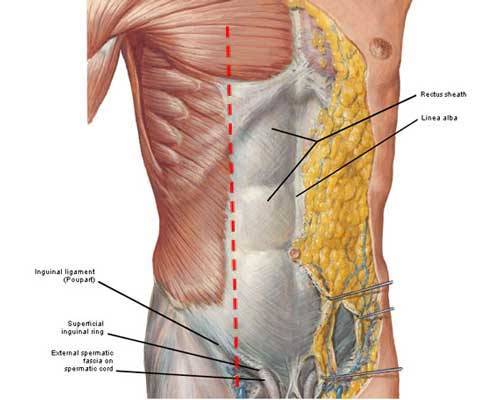
Photo F
I am breaking my own rule in this lesson by using an image of Graham McTavish because I havna got one of Dougal with his shirt off. Big D is sooo modest in the Starz series. So let’s pretend that this is fierce Dougal (Photo G). The red arrow marks the location of Dougal’s verra fine linea alba. Hopefully this will, erm, satisfy some readers who beg for more Dougal anatomy.
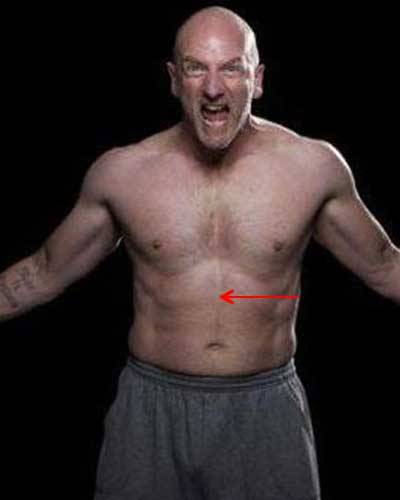
Photo G
I canna show Dougal-Belly and not show Frank-Belly. Now then Frank, “fair’s fair…take off yours, too.” Ha! Not too many surface features are visible here because Frank is seated, but we can see the location of his linea alba (Photo H):
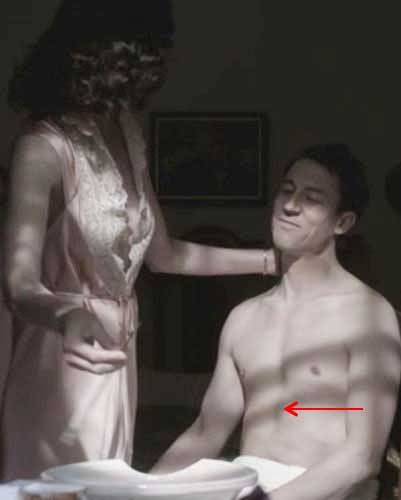
Photo H
Next, let’s examine muscles of the belly wall, all of which support our abdominal organs. Beginning at the sides, the most superficial pair is the external oblique (EO); each arises from the ribs (Photo I), turns tendinous, helps form the rectus sheath and inserts into linea alba, pubic tubercle and inguinal ligament. Whew! EO muscle fibers are directed downward and towards the midline.
Try this: place hands in the side pockets of jeans or similar trousers; the fingertips point the same direction as EO muscle fibers. Working together, EO muscles flex the trunk and compress the abdominal viscera. Working independently, each EO helps rotate the trunk.
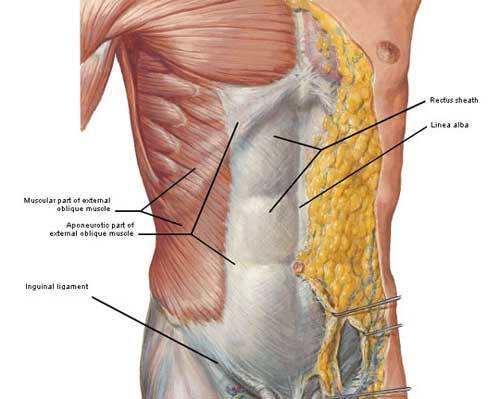
Photo I
Deep to each EO is an internal oblique (IO) muscle. Each IO arises from thoracolumbar fascia (Anatomy Lesson #10) and iliac crest, turns tendinous, helps form the rectus sheath and inserts into linea alba, pubic tubercle and inguinal ligaments (Photo J). Most IO muscle fibers are directed upward and towards the midline (90° to EO muscle fibers). Working together IO muscles flex the trunk and compress the abdominal viscera. Working separately each IO helps rotate the trunk.
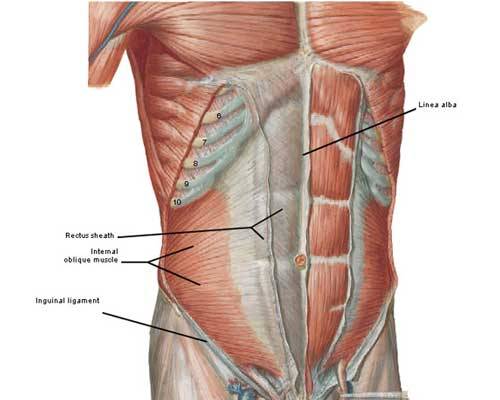
Photo J
Interestingly, when rotating the trunk as in cross crunches (Photo K) EO of one side works with IO of the opposite side. Here, left EO contracts with right IO to rotate and flex the trunk toward the
right knee. Note: when doing cross crunches, one should reach shoulder/arm pit (not elbow) toward the opposing knee.
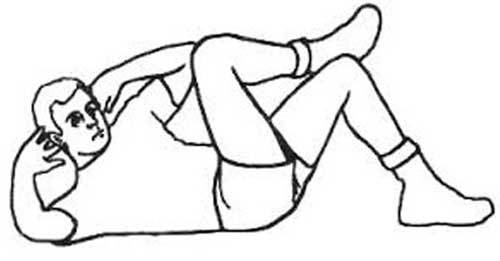
Photo K
Deep to each IO is transversus abdominis (TA), deepest of the side muscles (Photo L). TAs arise from costal cartilages, thoracolumbar fascia, iliac crests and inguinal ligaments and insert into linea alba and pubic bones. TA muscle fibers are horizontal and like EO and IO give way to a flat tendon that helps form each rectus sheath and linea alba. TA compresses and supports the abdominal viscera. They can be strengthened by doing exercises that tighten the belly wall (e.g. Pilates).
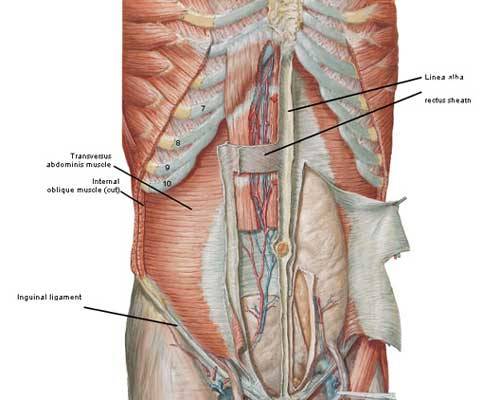
Photo L
Our final set of abdominal muscles is the paired rectus abdominis (RA); each is a flat vertical muscle extending from pubic bones to costal cartilages (Photo M) and is enveloped by its respective rectus sheath.
RA muscles are separated in the midline by linea alba. The lateral border of each RA is marked by a curved line, the linea semilunaris (Photo M – black arrows).
Tendinous Intersections: The grey horizontal bands are tendinous intersections (TIs), fibrous bands that traverse each RA. Most individuals have three TI per RA. The left RA shows three typical TIs and a partial fourth. Acting together RA muscles flex the trunk and compress abdominal viscera.
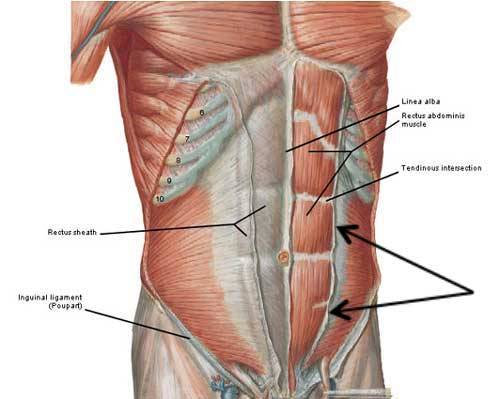
Photo M
If rectus abdominis muscles are well-toned, they bulge between the tendinous intersections accounting for the six-pack appearance of a muscular anterior abdominal wall. The man shown in Photo N has three pairs of TIs and three RA bulges: one set above the top TI, second set between top and middle TI, third set between middle and bottom TI. The belly below the navel is
not part of a six-pack.
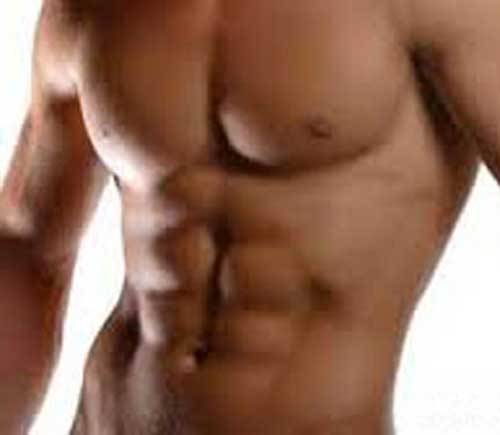
Photo N
Occasionally, a 4th and 5th pair of TIs appears below the navel resulting in an 8- or even more rarely a 10-pack ab. This man has four pairs of TIs – the 4th appears below the navel (Photo O – red arrow)
resulting in an 8-pack. This is not an anomaly, it just represents individual variation.
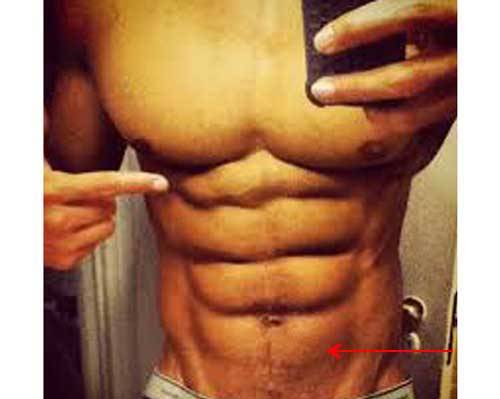
Photo O
TIs may be asymmetrical such that a pair of bands is offset relative to each other. In the image below (Photo P – red arrows) both woman and man have stair-step TIs. Again, this is individual variation and has no known functional significance.
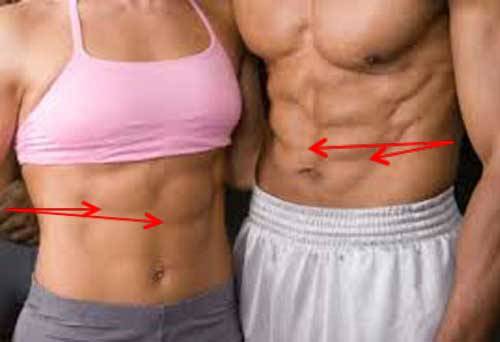
Photo P
Try this: Would you like your own 6-pack abs? Simple crunches help as they employ EO, IO and RA muscles. Crunches may be done many ways but a common method is to bend the knees with feet hip
distance apart and resting on the floor, elbows to the sides, hands resting lightly behind the head (Photo Q). Lift shoulder blades off the floor and repeat many, many, many times. But, more importantly for protection the lower back (lumbar region) remains on the floor and do not pull on the neck.
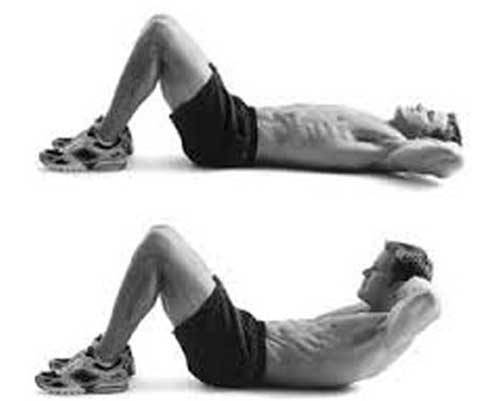
Photo Q
Now, for surface anatomy: Belly skin bears a number of topographical landmarks which are best observed in the lean and/or physically fit.
First, a vertical midline groove or furrow overlies the fibrous linea alba (Photo R) marking the medial border of each rectus sheath and its enclosed RA muscle.
Next, the umbilicus, navel or belly button lies near the center of the belly wall at the level of L3
– L4 IV disc (Anatomy Lesson #10). The umbilicus is a midline cicatrix or scar that marks the
attachment site of umbilical cord to body wall during prenatal life. Its size and shape vary considerably and with increased weight or distortion from pregnancy its placement may change. Although most human have an umbilicus, some do not. People may require surgical removal of the umbilicus due to herniation, birth defects, injury and infection or for elective cosmetic reasons.
The umbilicus bears a small opening or umbilical ring. Try this: Lie on your back, place a fingertip in the center of the umbilicus and press down. You may feel the small tight opening of the umbilical ring through which passed the umbilical vessels during intrauterine life.
Two curved vertical skin grooves are also visible on belly skin; lineae semilunares (Latin meaning half-moon lines) mark the lateral border of each rectus sheath and its enclosed RA muscle. These extend from costal cartilages to pubic tubercles.
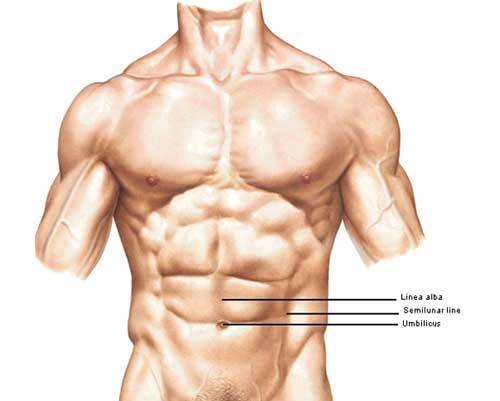
Photo R
Time for a Jamie-fix! Does Jamie’s belly show these surface features? Oh, aye, to be sure. The red arrow (Starz episode 2, Castle Leoch) points to the vertical furrow overlying linea alba. Ahhhh, now readers, quit looking at Jamie’s chest! I ken what ye are thinking. We are supposed to be
learning the belly wall. Erm, Clarie keep hold of your cleaning cloth!
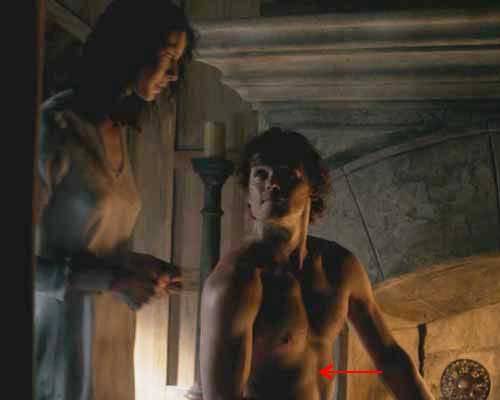
Here Jamie is suspended from ropes as the Mad Man of Fort William beats him the first time (Starz episode 2, Castle Leoch). The red arrows point to medial and lateral margins of the L rectus sheath which is tightened because he is hanging by his arms. Because both rectus sheaths are taut his tendinous intersections and rectus abdominis muscles are flattened. The point is this extended position stretches of his belly wall and its associated structures. No need to ask about his navel, I’ll tell ye: it is a little to the right because his hips are slightly twisted. Jamie has just spit, whether from pain or disgust or both, it’s a verra manly gesture and I love it! Ye can see three drops of spit falling near his navel.
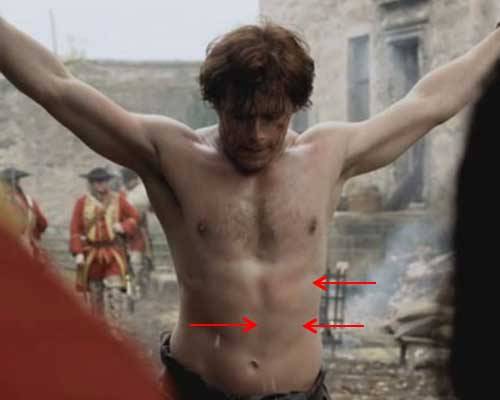
Keen observation also reveals Jamie’s L linea semilunaris (red arrow) marking the lateral margin of the same rectus sheath (Starz episode 2, Castle Leoch). Now Jamie, I’m not sure Claire is paying heed to your warning about being English in a place where that’s not a pretty thing to be –
appears to me that she canna stop looking at your belly wall and neither can we! Yeow!
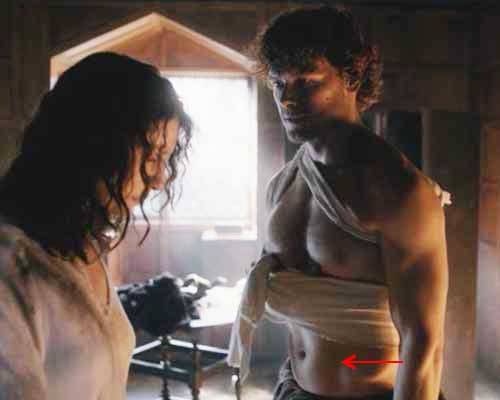
We’ll leave Jamie for a moment but dinna worry he’ll be our model again soon. Two other surface landmarks are pertinent to today’s lesson (Photo S). A toned belly shows three pairs of horizontal skin grooves. Each groove overlies a tendinous intersection of RA muscles. Remember, a well-developed RA bulges between the tendinous intersections causing the much-admired 6-pack abs!
Another pair of skin grooves extends obliquely from ASIS to pubic tubercles; these are the inguinal grooves and each overlies an inguinal ligament, marking the boundary between trunk and lower
limb (Photo S).
Try this: lie on your back and relocate ASIS and pubic tubercle. Press fingers about half way between these bony landmarks and feel a thick tough band, the inguinal ligament. Above this ligament is trunk; below it is lower limb.
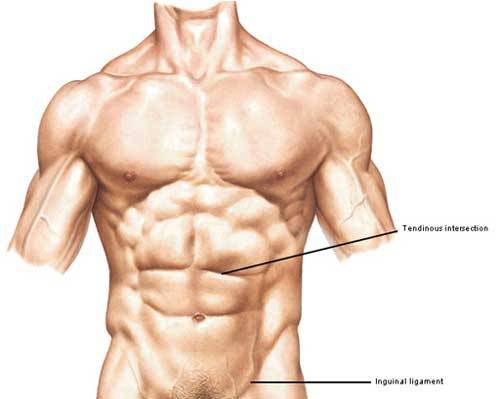
Photo S
Can we see Jamie’s tendinous intersections and does he have a six-pack? Och, aye, here is the Scottish six-pack in all its glory! Starz episode 6, The Garrison Commander shows his fine abs verra nicely. Arrows point to three pairs of tendinous intersections (TIs). To review: the top pair of TIs (red arrow) lies near the xyphoid process; the bottom TI pair (blue arrow) is near the navel; and the middle TI pair (green arrow) lies between the former two. Remember, in the physically fit, TIs divide each rectus abdominis muscle into bulging segments. Although his lower abdomen is covered by his carefully folded shirt, Jamie does not have a 4th pair of TIs (I’m the anatomist. I’m in charge – so I checked!). Snort!
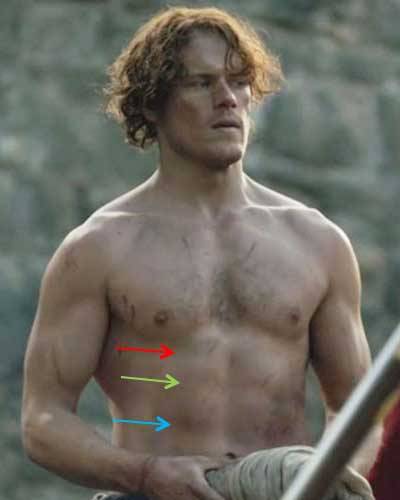
And finally, here is Jamie’s R inguinal groove overlying his R inguinal ligament after being struck by crazy Jack. Because his hips are modestly swathed in plaid we see only the upper half of the inguinal grooves. Wish someone would whip that whip out of Randall’s hands and administer a few smacks to his back.
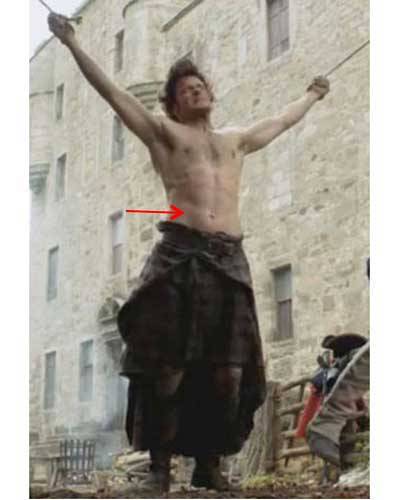
Pop quiz time! Next is an awesome image of Jamie from, well ye all ken where it’s from (Starz episode 7, The Wedding)! And, a lovely quote from the Outlander book:“
‘Because I want to look at you,’ I said. He was beautifully made, with long graceful bones and flat muscles that flowed smoothly from the curves of chest and shoulder to the slight concavities of belly and thigh.”
Woo hoo, are ye paying attention? Slow deeeeeep breaths! All five topographical features of belly
skin can be seen in this image:
Did ye find them? Would ye like to find them? Ha ha! Hopefully ye all got 100%.
Tcha, Jamie. Didna your mother, Ellen, teach ye not to stare? Gie the puir lass a break! (It’s OK if we stare though.)
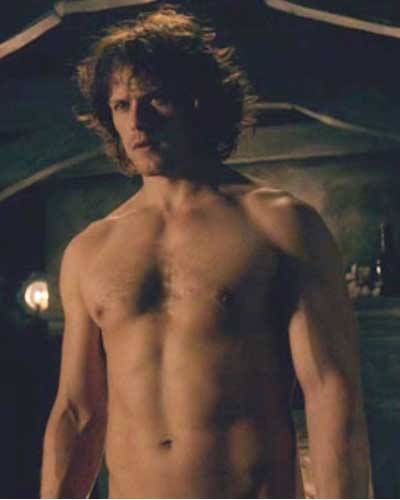
Sigh. Aye, it’s time to leave Jamie. Bye. Bye.
Now, for the promised true story…some years ago, I had delivered my yearly lecture to first year
medical students on anterior abdominal wall, spermatic cord, etc. A few weeks later, a student shared with me the following harrowing experience. He had just run in the New York Marathon (Photo T – student is not in photo). Weather was warmish and he decided to run wearing only nylon vest and running shorts. After running a few miles, he suddenly crumpled in agonizing pain and
immediately diagnosed his own problem (aye, he remembered the lecture!): as body heat increases, spermatic cords and scrotum relax allowing the testes to move more freely than usual.
His right testis shifted enough during the run to twist its spermatic cord thus strangling the testicular artery and cutting off blood flow. Known as testicular torsion, this is a true surgical emergency that can result in loss of the affected testis if not treated promptly. Paramedics took him to an emergency room where ER docs moved the testis to untwist the spermatic cord and restored its blood supply. Although this may sound slightly frivolous, it is not. Having seen pathology specimens of necrotic (dead) testes following torsion, it is a shocking sight as this organ cannot tolerate loss of its oxygen supply!
I congratulated him on the outcome of quick medical intervention. Needless to say, my future lectures included this prime example of a choice gone wrong (yes, he gave permission – with no identifiers). Men must take precautions to wear appropriate and supportive undergarments especially if a long run is planned. And just to emphasize the point, torsion is the most common cause of testicular loss in adolescent males!
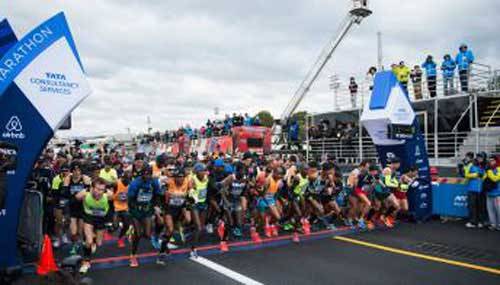
Photo T
Okay, you guy readers can start breathing now! The scary story is over.
I hope ye all enjoyed the verra important anterior abdominal wall lesson and appreciate its complex anatomy. Dinna forget – surface features of a muscular belly wall are based on its underlying anatomy. Fare thee well until my next lesson. In the meantime, please take good care of your amazing body!
A deeply grateful,
Outlander Anatomist
You can now follow me on Facebook and Twitter!
Photo creds: Starz, Gray’s Anatomy,
39th ed., Netter’s Atlas
of Human Anatomy, 4th ed., Clinically
Oriented Anatomy, 5th ed., Hollingshead’s
Textbook of Anatomy, 5th ed., Wikipedia, pixshark, workoutnirvana, simplyshredded, the-fitness-motivator, fitnessversusweightloss, build-muscle-101, wikihow, running.es, popworkouts.
Greetings everyone! Welcome to Anatomy Lesson #15: The Thoracic Cage. Now, don’t leave this lesson just because the title doesn’t include Jamie! He’s up next time. Promise.
This lesson follows the fascinating self-defense session from Starz episode 8, Both Sides Now, wherein Angus teaches Claire how to kill using the sgian dhu or hidden dagger. Is Angus’ lesson accurate and are his descriptions anatomically correct? Read on and find out. It will be interesting, I assure you.
A wee note of explanation: I analyze the images and self-defense lesson as an academic. If my comments seem cavalier, please know that the topic matter is difficult for me, too.
Now, knives flash everywhere in this episode. Mayhap RDM wrote it?
Knives are not my specialty (although I’m, um, good with a scalpel) but let’s start the topic with a brief intro to the sgian dhu. Apparently, 17th and 18th century Scots carried this dagger hidden in the sleeve or lining of a jacket. As a guest, however, proper courtesy and etiquette required that Highlanders remove the weapon from hiding and display it in a stocking top (Photo A – red arrow) as depicted in this elegant and manly portrait of Alasdair Ranaldson MacDonell of Glengarry (Henry Raeburn, artist – 1812).
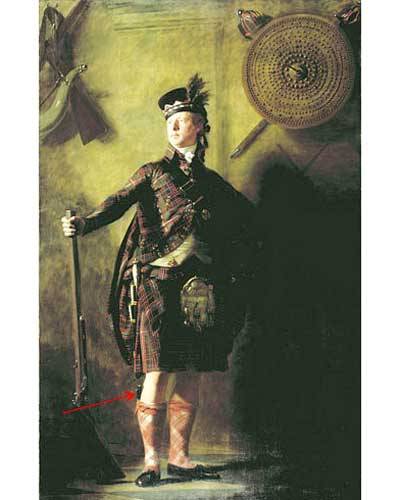
Photo A
If ye recall, an important event leads to Claire’s sgian dhu lesson. Just blame it on the crouching Grants! Aye, those sneaky dudes were hidden in the rocks under veil of darkness with pillage on their minds. Springing from their hiding place, they attack the MacKenzie party and ruin Rupert’s mellifluous waterhorse tale; what a voice that man has!
Happily, Dougal and his fighting warriors quickly prevail and Uncle is so delighted that, wonder of all wonders, he hugs his nephew! I’ve burned this image on my retinas thinking it may be the only time we see Dougal show affection for the lad. Wait ‘til Jamie hears that his uncle has the hots for his new wife…probably no hugging after that.
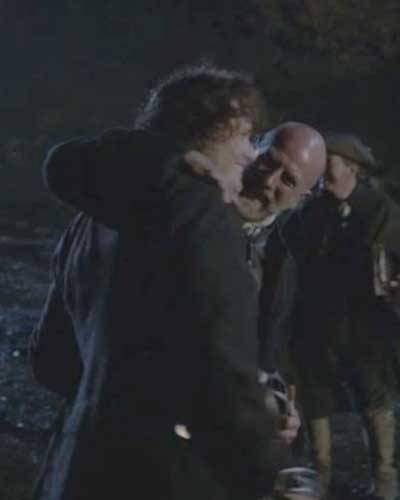
Next morning the search is on for Jamie’s dirk, lost by Claire during the nighttime scuffle. Ah, gie it to my wife. But alas, the dirk willna work for the lass.
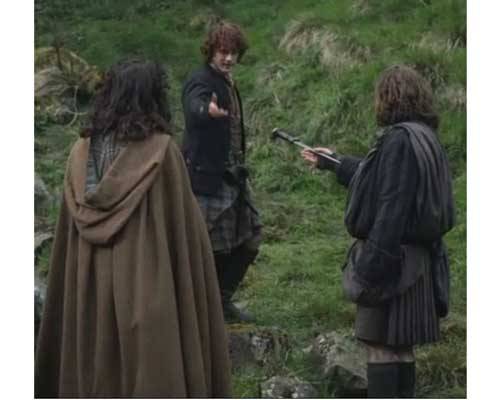
Ned Gowan thinks that someone should teach this leddy how to defend herself. Jamie agrees and war chief Dougal sits honing his dirk with a stone. Ever dapper in his wool bonnet and tidy beard, he intones that “the lass needs a sgian dhu.”Claire is – huh? – until her ruadh gallant translates: “sgian dhu, hidden dagger!”
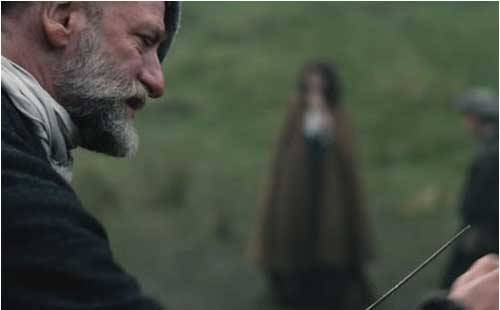
So, does anyone have a sgian dhu for Claire? To be sure, that crusty solicitor Ned, does. A lot of folks keep theirs hidden in a stocking, but he keeps his “in another more private place”… ahem, who knew? Willie (what a cutie) thinks Ned’s hiding spot is verra clever. Careful Ned, ye need all those body parts and passions lest you lose face time with the strumpets!
Herself writes in the Outlanderbook:
“The tiny sgian dhu, the sock dagger, was deemed acceptable, and I was provided with one of those, a wicked-looking, needle-sharp piece of black iron about three inches long, with a short hilt.”
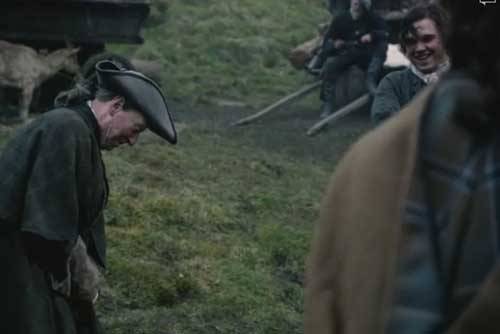
OK, she’s got a knife but who will give her a lesson? Turns out Angus is “a good man with a blade!” and he’s been waiting to teach Claire a thing or two. I recall him thrusting his dirk while watching Claire in the surgery at Castle Leoch (Starz episode 3, The Way Out) and trying to get a wee “keek at her breests” on her wedding night (Starz episode 7, The Wedding). Naughty Angus!
Herself records in the Outlander book (Here, Rupert is the teacher):
“So I was marched out into the center of a clearing and the lessons began… After a good deal of amiable discussion, they agreed that Rupert was likely the best among them at dirks, and he took over the lesson.”
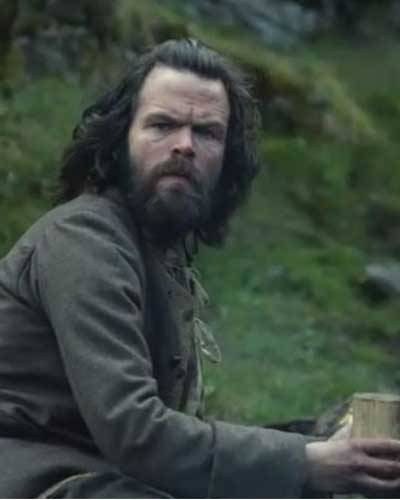
Again from Herself’s own hand (Outlander book):
“He found a reasonably flat spot … in which to demonstrate the art of dagger-wielding … “Generally, ye want to use the underhand; overhand is only good when ye’re comin’
down on someone wi’ a considerable force from above.”
Angus demonstrates to dubious Claire several fierce upward jabs with the wee wicked weapon (dare ye to say that rapidly three times in a row).
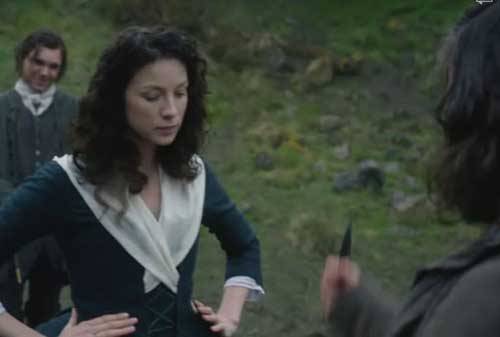
“Aim straight up and as hard as you can into the heart” is Angus’ genteel advice. First try, Claire stabs upward near Angus’ breast bone and gets a warning! Noooo……. Dinna ye love the look on Angus’ face? He’s such an avid teach!
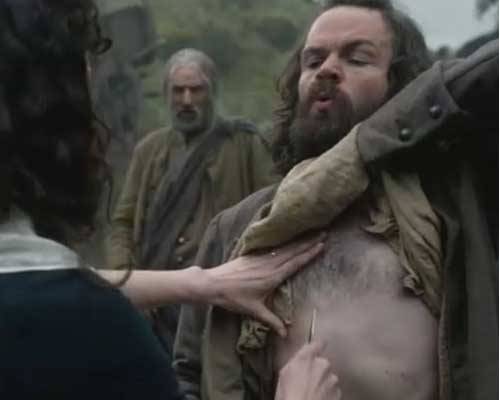
“Uh, oh, avoid the breast bone – you get your knife stuck in that soft part at the top and you’ll be without a knife.”
Whoa, there’s a tip-top issue here. Angus, did ye really say “at the top?” Ah, well, now, the adult human breastbone doesn’t have a soft spot at the top. After all, we aren’t chickens (well, maybe sometimes) …. I checked the CC script and sure enough the word is top. But, I think Angus says tip not top in which case, he is correct because the breast bone tip can be soft (see below). Mayhap he was misunderstood? Who cares? Anatomists to be sure. Otherwise, Angus’ anatomy lesson is flawless. Bravo professor Angus!
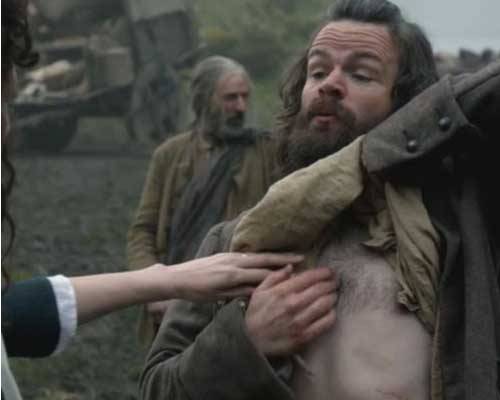
Lest Angus and Claire get too far ahead of us, let’s halt the lesson and start our own. Gruesome as it may seem, this lesson presents us with a fine opportunity to explore the thoracic cage and vital organs it protects. The thorax is the upper part of the trunk easily distinguished from abdomen because the former contains ribs. From the front, the thorax occupies the region shown in blue (Photo B) and is partially overlaid by chest and abdominal muscles.
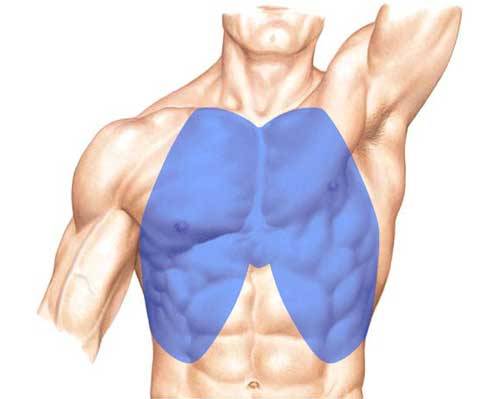
Photo B
The bony foundation of the thorax is the thoracic cage composed of thoracic spine (Anatomy Lesson #10), sternum, ribs and rib cartilages (Photo C). Let’s examine these structures.
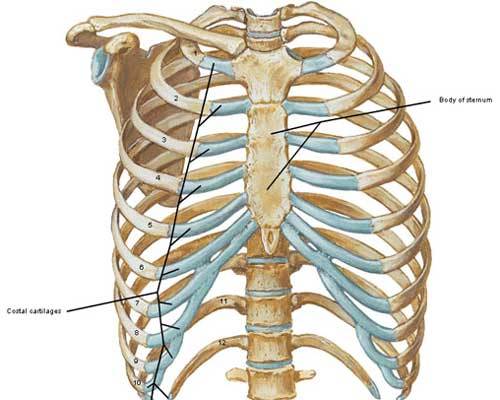
Photo C
Being verra imaginative men, early anatomists visualized the sternum as a sword and named its components accordingly. Can ye see the sword in Photo D? The sternum is divided into three parts:
At birth, the sternum is typically six separate pieces of cartilage and bone. By 18-22 years, the segments ossify (become bony) into a single bone although the tip may remain soft (cartilaginous) until about age 40. So, yes, Claire’s knife could get stuck in the soft tip – not top!
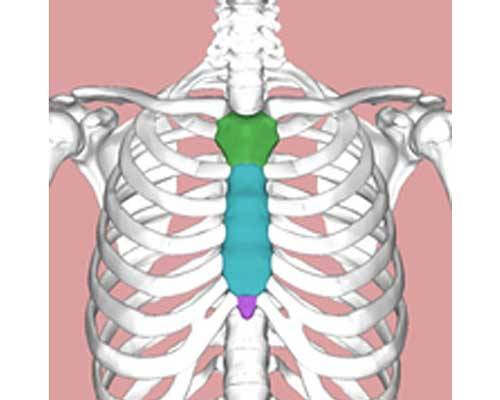
Photo D
The manubrium (Latin meaning handle) is fused with the body and articulates with costal cartilages of 1st and 2nd ribs (Photo E). It bears the midline jugular or suprasternal notch (Anatomy Lesson #12) and articulates with the clavicles (Anatomy Lesson #2) at paired sternoclavicular joints.
Try this: place a finger in your jugular notch and feel bony knobs at each side, the sternoclavicular joints. These are usually visible in a mirror; the thinner the person, the more prominent the joints. With a finger on one joint, lift, lower, pull forward, pull backward and rotate the same shoulder; feel the movement? This is truly amazing because the entire skeleton of each upper limb articulates with the thorax only at this single bony contact point!
The body or gladiolus (Latin meaning sword – as in gladiator) is the largest section of sternum; it is fused with manubrium, above and xyphoid process, below. It also articulates with costal cartilages
of ribs 2 – 7. Please palpate yours.
The xyphoid process (Greek meaning sword-like) is fused above with the body but terminates as a free end. Highly variable in shape, it may be curved, depressed, forked, deviated or pierced by a hole. Rarely it remains cartilaginous beyond 40 years.
Try this: suck in your breath as much as possible, hold your breath and lift the chest. Palpate the free tip of your xyphoid process – press gently as it may be tender.
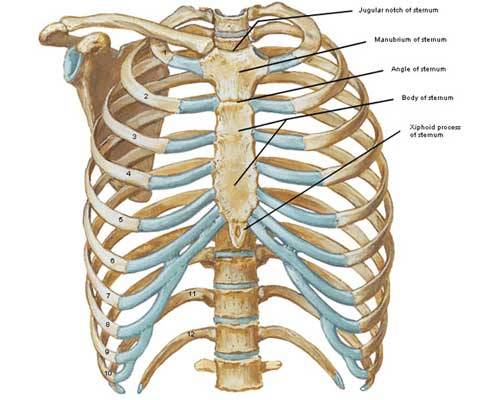
Photo E
Now, for the ribs: humans typically have 12 pairs of ribs (Photo F). Ribs 1-7 are true ribs because their costal cartilages directly join the sternum; ribs 8 -10 are false ribs because their costal cartilages join with costal cartilages of ribs above (Photo F – black arrows); ribs 11 and 12 are false and floating ribs because they do not join either costal cartilages or sternum. The joined costal cartilages of ribs 7 -10 form right and left costal margins.
Try this: holding your breath, run fingers along the free edge of the left ribs – this is your left costal margin.
Variations in rib count do occur: some individuals may have cervical or lumbar ribs or they may have only 11 pairs. Because of location, cervical ribs can compress arteries and nerves in the neck producing neurological and vascular symptoms. Otherwise, such variations are rarely a source of concern.
Between adjacent ribs are intercostal spaces, 11 pairs total (Photo F – red brackets). Although they appear large and empty in the image below, in life they are narrow and filled with intercostal muscles and fibrous tissue.
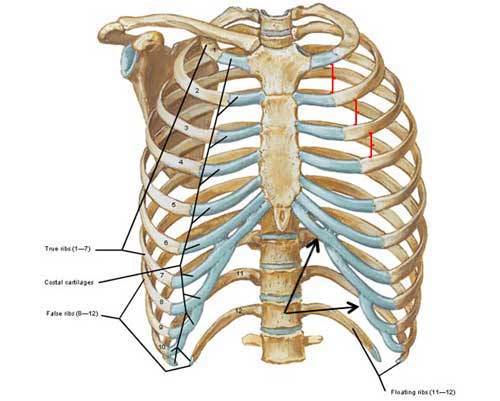
Photo F
Ribs vary in size and shape but each has a head (Photo G) which articulates with the bodies of two adjacent vertebrae and the intervening IV disc (Anatomy Lesson #10). Interestingly, if an individual rib is placed on a flat surface, it is seen as a twisted arch that will not lie flat. This twist affects the shape of thoracic cage and intercostal spaces.

Photo G
Another important feature of the rib cage is the manubriosternal joint also known as the sternal angle of Louis. Here, the union between manubrium and body creates a palpable bump (Photo H – side view) and is the level where the costal cartilages of the second ribs attach to the sternum. It is of clinical importance as various structures and anatomical boundaries occur at this joint.
Try this: place fingers in your jugular notch and work downward (about 2” or 5 cm) until you feel a bump; this is the sternal angle of Louis, a very useful landmark for health care workers to count ribs and determine locations of various thoracic structures. Men have more pronounced sternal angles than do women.
Occasionally, my acquaintances wish to wear heavy necklaces but cannot because of neck pain. I explain that they can likely wear heavy necklaces but only if the jewelry doesn’t fall below the sternal angle. If a heavy necklace is short, then clavicles and manubrium help support weight and relieve neck strain. Try it…
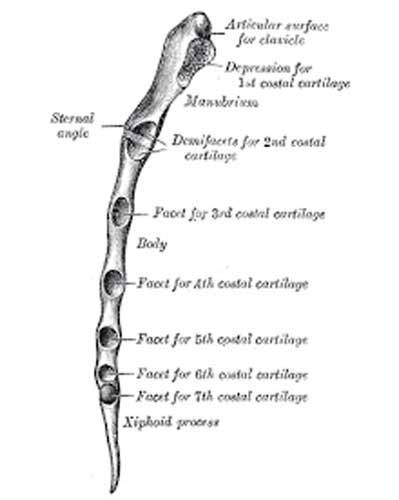
Photo H
Now, back to Angus’ lesson… Next, he redirects Claire’s knife from his sternum to left rib cage. He tells her to stab straight up and into the heart. Having some acumen with a scalpel too, Claire “follows a man’s orders for once” (or wait, isn’t that twice?) with a thrust so convincing that Rupert laughs: “Oh, dinna kill him yet mistress. Wait ‘til the lesson is over!”
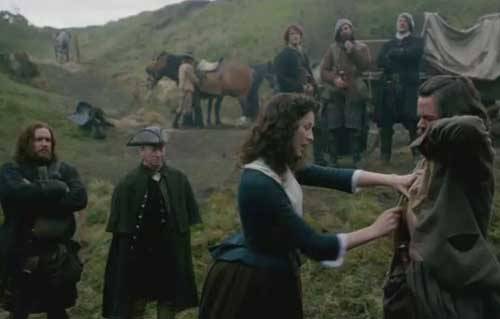
Now, is Angus correct: can a 3” blade reach the heart? Oh, aye – Angus scores again! The thoracic cage protects vital organs including heart, lungs and great vessels. In the following image (Photo I – anterior view) we see the heart in blue overlay with left and right borders shown in silhouette. Although the respiratory diaphragm divides thoracic and abdominal cavities, it rises surprisingly high under cover of the ribs. The heart sits atop the diaphragm and the abdominal liver is just below. Much of the heart lies protected behind the sternum but its point or apex reaches to the left (model’s left – not your left). A backward thrust with a sgian dhu pierces liver, too far left and it pierces lung. To reach the heart the blade must be thrust upward as hard as possible under the left ribs near the sternum so it pierces thoracic diaphragm and heart (yellow arrow).
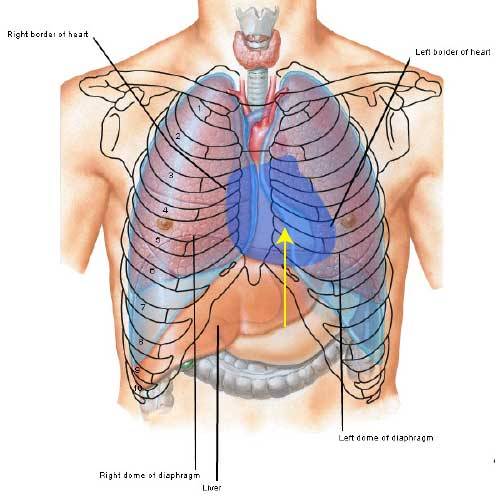
Photo I
Next, does the shape of the rib cage matter to a sgian dhu wielder? Weel, it should. Angus, for example, has a narrow rib cage and a narrow subcostal angle (Photo J – red lines) formed by union of costal cartilages and xyphoid process. The subcostal angle varies considerably from person to person. A typical angle is roughly 70° but some individuals have a wide rib cage and subcostal angle making a thrust to the heart easier to, erm, execute. In such people, the angle may exceed 100° allowing for a more successful stab.
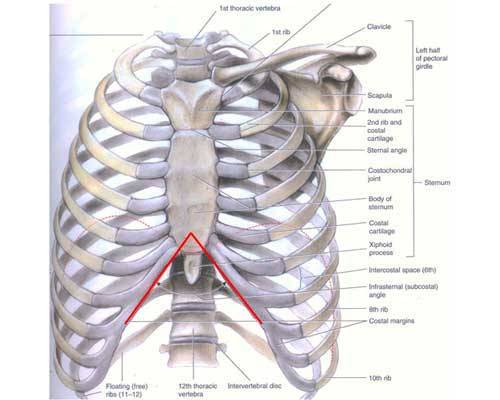
Photo J
Taking the lesson very seriously, Angus next teaches Claire how to “kill from behind.” Sweet Willie is the model (Murtagh in Outlander book). Poor guy, he gets his share of abuse on this, his first rent trip.
And another fabulous Outlander quote from Herself (again, Rupert is teacher):
“I was timid and extremely clumsy at first, but Rupert was a good teacher, very patient and good about demonstrating moves, over and over.”
Aye, Angus is an excellent teacher as he patiently explains: “Now, this is the spot in the back. Either side will do. Now, you see all the ribs and such? Very difficult to hit anything vital when you stab in the back.”
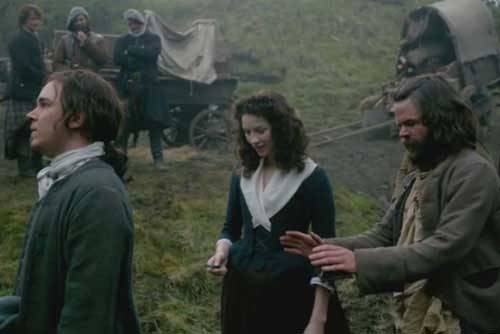
He continues: “Slip the knife between the ribs, huh? That’s one thing but a lot harder than ye might think.” Now, is Angus correct about stabbing between the ribs, and if so, why? Stay with me now…
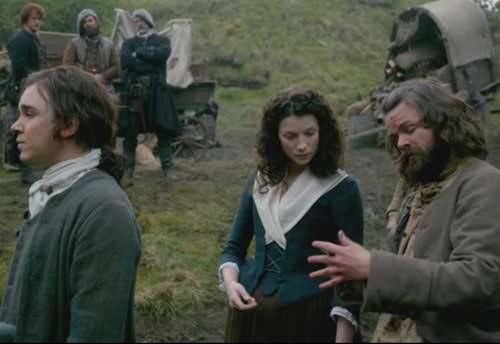
Yes, Angus is right! There are three reasons why stabbing between the ribs is difficult. As I explain, please recall that intercostal spaces are filled with intercostal muscles and fibrous tissue (Photo K).
Try this: place a finger in an intercostal space and breathe in as deeply as possible. Feel the change in width at deepest inspiration and again with complete expiration. During deep inspiration, the greatest width is discernible; with deep expiration, you’ll be lucky to feel an intercostal space at all. This reality greatly diminishes the chance of a successful stab into an intercostal space.
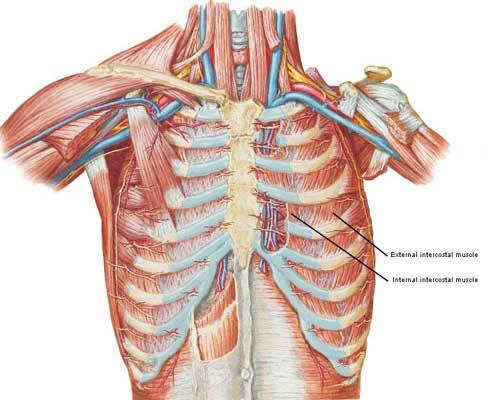
Photo K
Returning to the knife lesson, Angus instructs Claire to place her dagger “Here just under the last rib, you stab upward and into the kidney. Straight up – They’ll drop like a stone.” Whew, talk about a backstab! So, Nurse Claire delivers a well-placed thrust “straight up and in. See? Got it.”
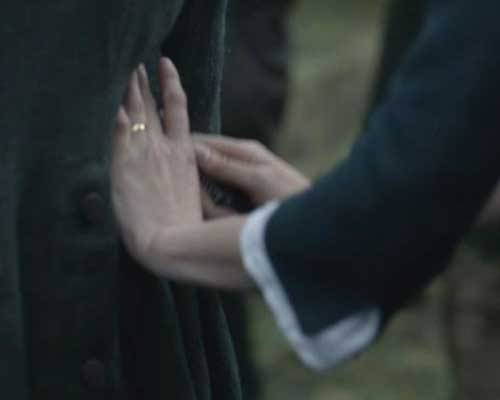
So how did Claire do with her lesson? Was she a good student? Jamie’s proud of her knife skills and he can’t wait to get her alone so he can prove it; Murtagh’s thinking that mayhap Claire’s best weapon isn’t poison; and Dougal, well, that’s an admiring eye to be sure! Not sure what’s on yer mind Uncle, but ye best not share it wi’ Jamie!
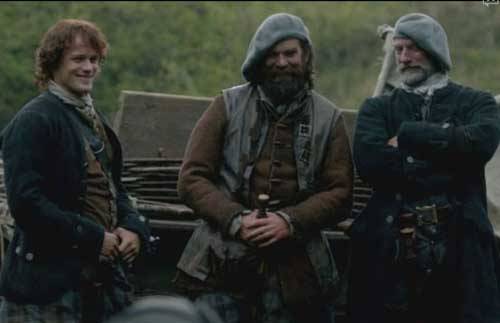
So, is Angus right – can a 3” blade reach the kidneys from behind? Oh, aye, he scores again! Angus, you are on a roll, man!
Let’s see why. From behind, the thorax includes the area shown in blue (Photo L) and here, the underlying thoracic cage is formed of posterior ribs and thoracic vertebrae (Anatomy Lesson #10).

Photo L
In the back, latissimus dorsi and erector spinae muscles (Anatomy Lesson #10) cover the 11th and 12th ribs of the thoracic cage and deeper yet are the paired abdominal kidneys flanking the spine (Anatomy Lesson #8). A posterior view with muscles removed shows upper poles of right and left kidneys (Photo M- blue overlay) protected by 11th and/or 12th ribs. Note that the right kidney sits lower than the left making it more vulnerable to a knife thrust. This occurs because the right lobe of liver is considerably larger than the left lobe, displacing the right kidney downwards.
But, Angus is correct, either side will do: a 3” blade thrust under either 12th rib near the spine will surely strike a kidney and mayhap its renal artery. Ye may recall that the kidneys receive roughly 22% of the cardiac output (Anatomy Lesson #8)? This extremely high blood flow causes quick and profuse bleeding in the event of a significant laceration. Shock alone from such a wound could cause a person to “drop like a stone”. Although not always in the back, kidney stabs are fairly common injuries seen in urban ERs.
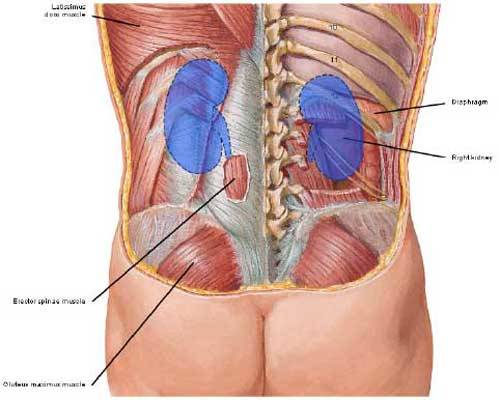
Photo M
Harry a redcoat deserter soon provides Claire with a chance to apply her sgian dhu lesson. Talk about coitus interruptus! Those deserters sure know how to rain on a parade.Warning: If you dinna wish to see or read details about the stab wounds, please skip the next paragraph and three subsequent images.
Herself records the horrific, teeth-jarring attack in the Outlander book (Rupert and Murtaugh – not Angus and Willie):
“I lay back, breathing heavily. I concentrated on my objective, trying to erase everything else from my mind. It would have to be in the back; the quarters were too close to try for the throat….I could see Rupert’s blunt finger stabbing at Murtagh’s ribs, and hear his voice, “Here, lass, up under the lowest ribs, close to the backbone. Stab hard, upward into the kidney, and he’ll drop like a stone……..I slipped my left arm around his neck to hold him close; holding the knife hand high, I plunged it in as hard as I could……… Unable to see, I had aimed too high, and the knife had skittered off a rib. I couldn’t let go now…”
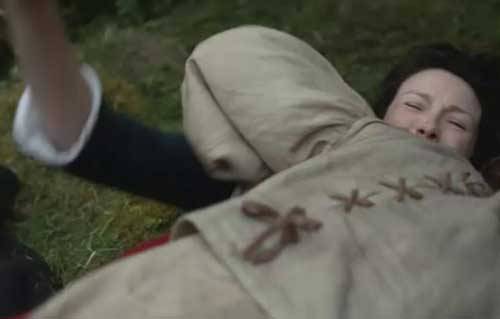
“I stabbed again, with a desperate strength, and this time found the spot. Rupert had been right. Harry bucked in a hideous parody of the act of love, then collapsed without a sound in a limp heap on top of me, blood jetting in diminishing spurts from the wound in his back.”
BTW, happy is the anatomist to see the bright red color of arterial (not dark venous) blood from the stab wound in Harry’s back.
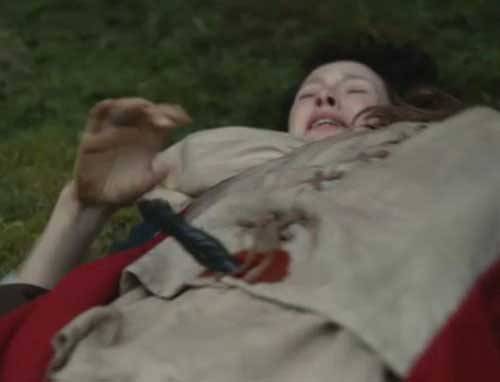
Now, its Jamie’s turn…… his dirk flashes and Arnold instantly joins his pernicious pal in death! Oh, aye, knives are everywhere in this episode!
From the Outlander book, Herself shares:
“Arnold’s attention had been distracted for an instant by the spectacle on the ground, and an instant was more than long enough for the maddened Scotsman he held at bay. By the time I had gathered my wits sufficiently….. Arnold had joined his companion in death, throat neatly cut from ear to ear by the sgian dhu that Jamie carried in his stocking.”
Whew! Jamie’s kill is so swift that I canna capture even one still image of the carnage!
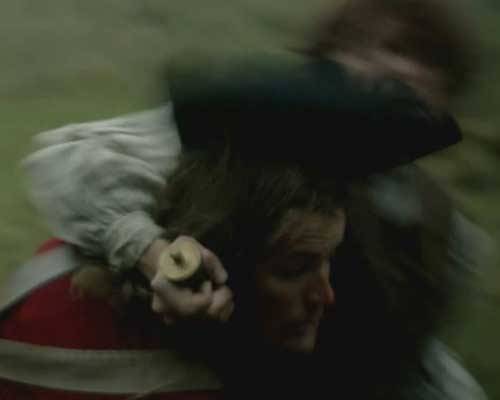
And, not to be outdone by the other card-carrying knifers in episode 8, that crazy bastard, BJR, uses his own blade to harass and torment a terrified Claire. Not only does he destroy her pristine white fichu (how can that be after weeks of camping in mud and dirt?) but he cuts her lacings and tears her shift (aye, he’s a bodice ripper!). But, BJR isna really interested in women or their soft bodies; he wants intel and likes torture.
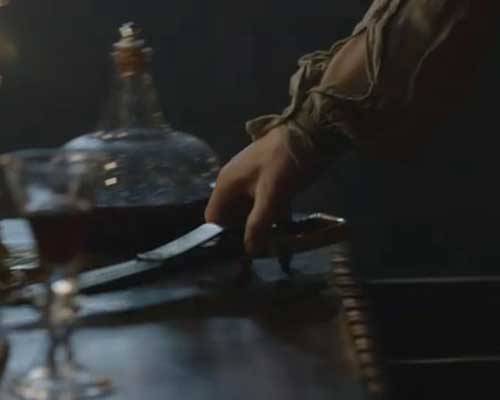
And, where is Claire’s hidden dagger when she needs it? Och! Safely hidden in the top of her lace-up leather boot whice she can’t reach (not bent over a desktop face-first with her skirts up)! Too bad Claire, otherwise ye could teach BJR your own wee dagger lesson! He’s earned it!
Pssst: just between you and me, I am fairly sure that Claire’s boots at Fort William are not the same ones she wears while climbing Craigh na Dun; the latter look a bit like UGGs! Mayhap there’s a Zappos near the fairy stones??
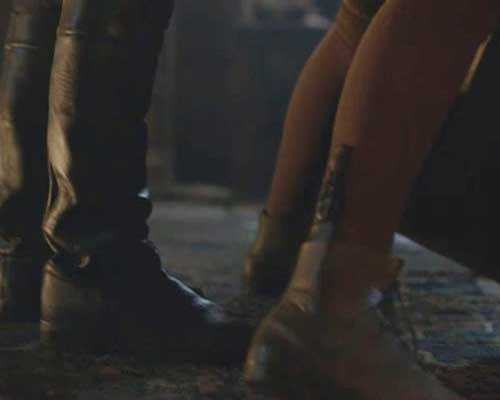
After all the blood and gore, let’s end this anatomy lesson on a happy note! Here’s the funny sequence between Jamie, Claire and Rupert over Jamie’s lost dirk after the crouching Grant’s attack. It happens so fast that ye may have missed the full effect. So here it is in slow-mo…
Ye recall Claire sighing that Jamie’s dirk is too long and heavy for her? With a huge, cheeky grin plastered on his face, Rupert chuckles “all the lasses say that to me.” Claire looks faintly disgusted. But lass, what’s wrong? Have ye never heard a man make a joke before? Aye, this time he’s the witty one!

Oops! Not sure Jamie likes the double entendre… Suddenly, a wary Rupert isn’t grinning. I wish the camera had caught Jamie’s face as he swings toward the jokester.
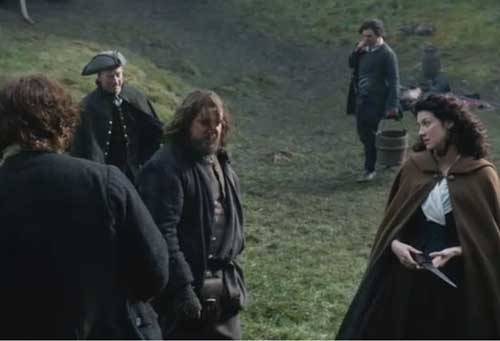
Um, Rupert, ye best get while the getting’s good! Jamie doena like other men making ribald jokes to his wife. It’s one thing to pummel Jamie when he willna fight back, but ye likely won’t win if and when he decides ye are fish bait.
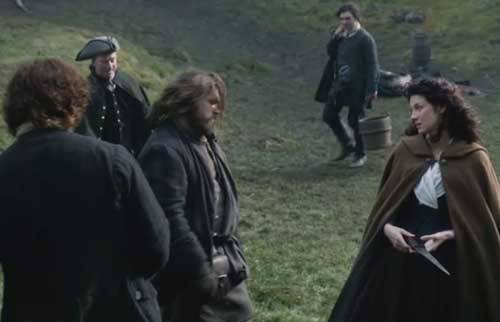
Aye, Rupert gets the message. Off he goes!
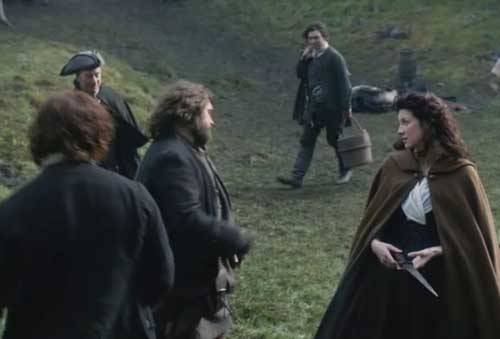
Claire finds the joke a wee bit amusing but Jamie isna smiling. Bye, bye, Rupert. For a big man, ye move pretty fast!
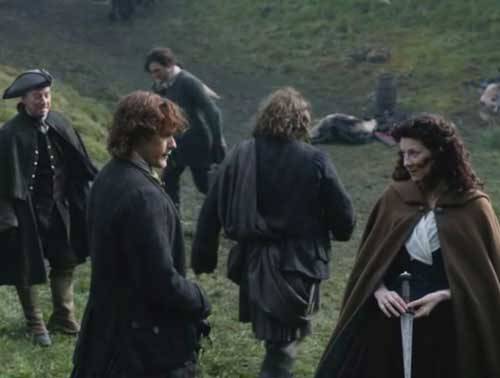
So, Jamie gets back his knife and rewards Claire by showing off. It’s not the first time we’ve seen him, erm, play with his blade. As Claire kens well, he’s darn good with a blade!
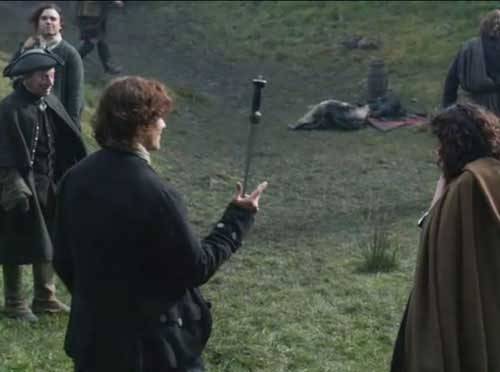
In closing, remember that the thoracic cage is a bony envelope formed of sternum, ribs, costal cartilages and thoracic vertebrae; it is engineered to protect vital organs including heart, lungs, great vessels and kidneys. Although vulnerable to trauma, a stab attack to the thoracic cage and its enclosed organs must be executed effectively to impose lethal harm. Mayhap Angus should teach the next Anatomy Lesson, you say? If I need guidance, I’ll ask. Snort!
A deeply grateful,
Outlander Anatomist
You can now follow me on Facebook and Twitter!
Photo creds: Starz, Gray’s Anatomy,
39th ed., Netter’s Atlas
of Human Anatomy, 4th ed., Clinically
Oriented Anatomy, 5th ed., Hollingshead’s
Textbook of Anatomy, 5th ed., www.Wikipedia.org